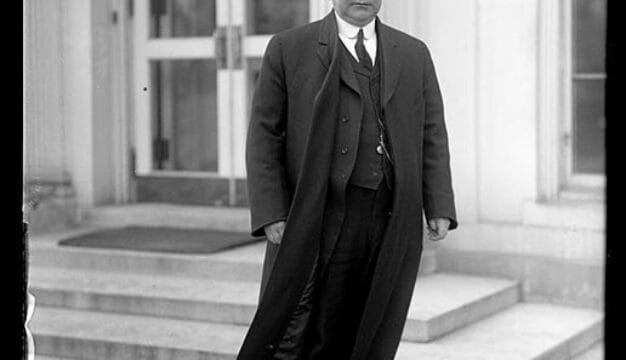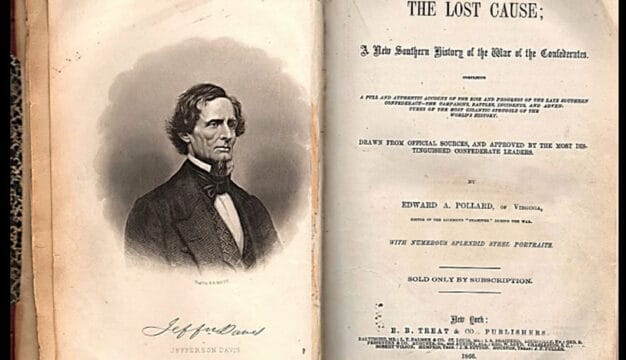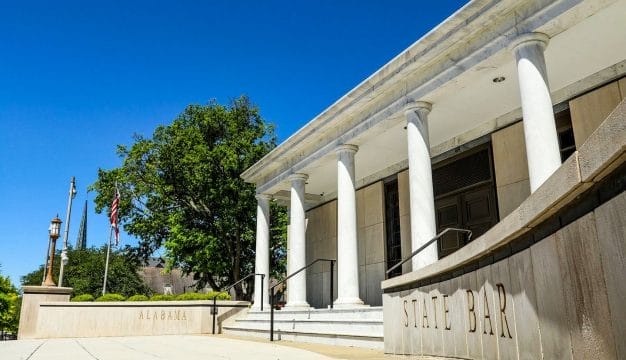Birmingham Cholera Outbreak of 1873
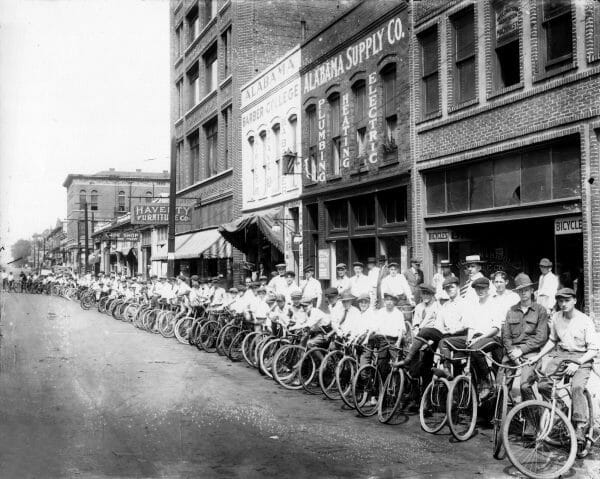 Louise Wooster’s Fourth Avenue Buildings
Just two years after its founding, Birmingham, Jefferson County, was beset by a deadly cholera epidemic during the summer months of 1873 that killed 128 people. The disease spread rapidly throughout the city after it entered the water supply. As the death toll rose, people fearing for their lives flooded out of the city; many chose not to return.
Louise Wooster’s Fourth Avenue Buildings
Just two years after its founding, Birmingham, Jefferson County, was beset by a deadly cholera epidemic during the summer months of 1873 that killed 128 people. The disease spread rapidly throughout the city after it entered the water supply. As the death toll rose, people fearing for their lives flooded out of the city; many chose not to return.
Cholera, an intestinal infection caused by the bacterium Vibrio cholerae, is passed by contaminated food and water and causes severe diarrhea and dehydration. Birmingham was founded near profitable natural resources and not in the vicinity of a major water supply, a factor which greatly assisted the spread of the disease. The city’s residents had only one sanitary source of water in 1873, a creek’s reservoir located nearly two miles outside of the city. In contrast, ground wells were the city’s other option, but were located in the city’s lowest elevations and filled with groundwater that ran down from higher elevations, making them far less sanitary.
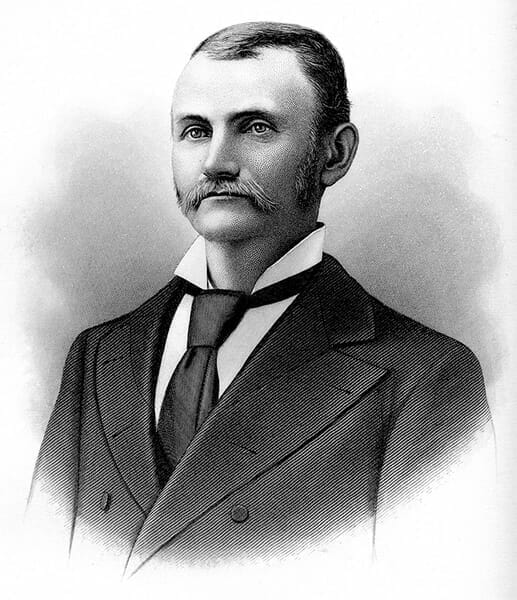 Mortimer Jordan
The first reported case of cholera in Birmingham dates to June 12, 1873. The individual considered to be the first to carrier of the disease, known to history only as Mr. Y., had recently moved to Birmingham from Huntsville. Mr. Y. was in Birmingham six weeks before falling ill with cholera, displaying symptoms three days after his bed and bed accessories arrived from Huntsville, which was suffering through its own epidemic at that time. Thus, the disease is believed to have arrived in Birmingham by way of Mr. Y.’s belongings. Mr. Y. died shortly after he began suffering from the vomiting and diarrhea associated with cholera. Local physician Mortimer H. Jordan suspected cholera, but his records indicate that the doctors who treated Mr. Y. did not identify the disease as the cause of death. Thus, doctors did not demand the proper disposal of Mr. Y.’s bodily fluids or bedding. Typically, bodies, body fluids, and other items contacted by cholera victims were disinfected with carbolic acid and buried, and bedding and clothing would have been burned. On June 17, two sisters came down with the disease and died shortly after falling ill. As with Mr. Y., no one properly disposed of the sisters’ body fluids.
Mortimer Jordan
The first reported case of cholera in Birmingham dates to June 12, 1873. The individual considered to be the first to carrier of the disease, known to history only as Mr. Y., had recently moved to Birmingham from Huntsville. Mr. Y. was in Birmingham six weeks before falling ill with cholera, displaying symptoms three days after his bed and bed accessories arrived from Huntsville, which was suffering through its own epidemic at that time. Thus, the disease is believed to have arrived in Birmingham by way of Mr. Y.’s belongings. Mr. Y. died shortly after he began suffering from the vomiting and diarrhea associated with cholera. Local physician Mortimer H. Jordan suspected cholera, but his records indicate that the doctors who treated Mr. Y. did not identify the disease as the cause of death. Thus, doctors did not demand the proper disposal of Mr. Y.’s bodily fluids or bedding. Typically, bodies, body fluids, and other items contacted by cholera victims were disinfected with carbolic acid and buried, and bedding and clothing would have been burned. On June 17, two sisters came down with the disease and died shortly after falling ill. As with Mr. Y., no one properly disposed of the sisters’ body fluids.
The impoverished, primarily African American neighborhood known as the “Baconsides” faced the greatest hardship during the first days of the epidemic. The sisters who contracted cholera after the death of Mr. Y. lived on the hill just above the Baconsides, and it is believed that their improperly managed body fluids contaminated the water supply in the community. Cholera was rampant in the neighborhood during the final days of June. After roughly 10 days of widespread deaths there, the disease migrated into the general population.
None of the doctors in the Birmingham area had any direct experience with cholera, and they worked under several false assumptions. At the time, they thought that the disease plaguing the city was airborne in nature. Therefore, pots of tar were burned on street corners in the belief that the smoke would disinfect the air. On July 1, however, doctors acknowledged that the deaths were the result of cholera, which was known to be transmitted by water. After that, community leaders took steps to rid the city of the disease, including cleaning streets, draining and disinfecting city cesspools, and disinfecting and burying cholera-infected body parts and fluids.
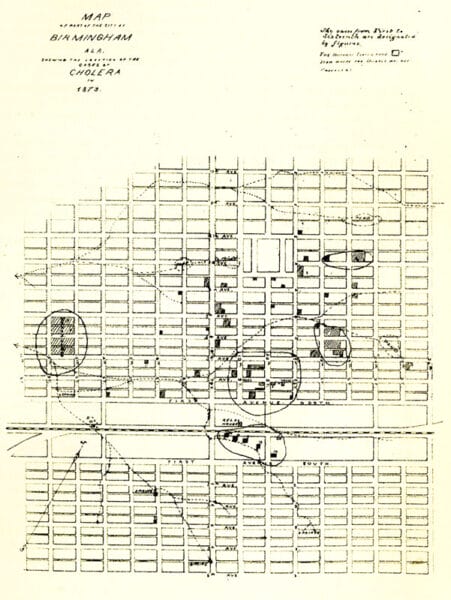 Map of the 1873 Cholera Outbreak
Many of the city’s doctors, including James B. Luckie and Jordan, remained in the city, as did a number of individuals who stayed and bravely attempted to aid the ill. These community-minded residents included local madame Louise Wooster and city alderman Francis P. O’Brien, who became so sick a casket was ordered and his obituary printed in a local paper, but he survived. Such acts of selflessness, however, were overshadowed by a mass exodus of people who feared for their lives. Whereas approximately 4,000 people had settled in the city by June of 1873, only half that number remained by the end of the summer.
Map of the 1873 Cholera Outbreak
Many of the city’s doctors, including James B. Luckie and Jordan, remained in the city, as did a number of individuals who stayed and bravely attempted to aid the ill. These community-minded residents included local madame Louise Wooster and city alderman Francis P. O’Brien, who became so sick a casket was ordered and his obituary printed in a local paper, but he survived. Such acts of selflessness, however, were overshadowed by a mass exodus of people who feared for their lives. Whereas approximately 4,000 people had settled in the city by June of 1873, only half that number remained by the end of the summer.
The local economy was devastated by the loss of population and an accompanying sharp decline in property values. Further, a national economic depression arrived on the heels of the cholera epidemic, significantly adding to the city’s problems. One positive development arose out of the epidemic, however. City leaders, faced with the inadequacy of water services, improved sanitary systems and increased the capacity of the recently established Birmingham Water Works, and Birmingham eventually recovered.
Additional Resources
Baggett, James L., ed. A Woman of the Town: Louise Wooster, Birmingham’s Magdalen. Birmingham: Birmingham Public Library Press, 2005.
Bennett, James R. Historic Birmingham & Jefferson County. San Antonio, Texas: Historical Publishing Network, 2008.
Caldwell, H. M. History of the Elyton Land Company and Birmingham, Alabama. 1892. Reprint, Birmingham: Southern University Press, 1972.
Rosenberg, Charles. The Cholera Years. Chicago: University of Chicago Press, 1962.
Cholera Epidemic of 1873 in the United States. The Introduction of Epidemic Cholera Through the Agency of the Mercantile Marine: Suggestions of Measures of Prevention. Washington: Government Printing Office, 1875.

